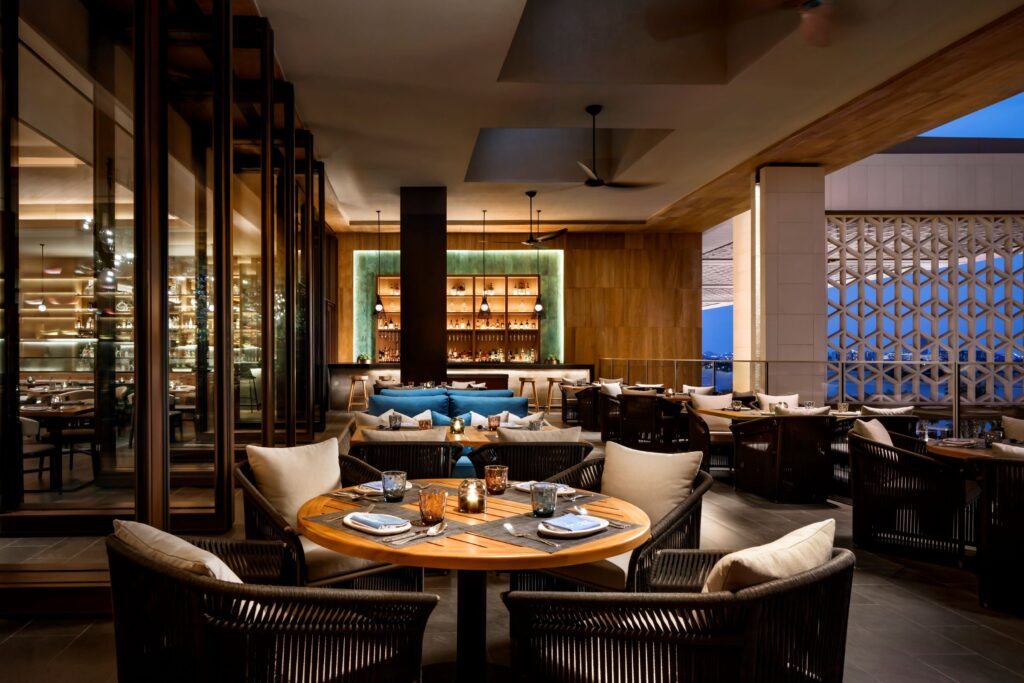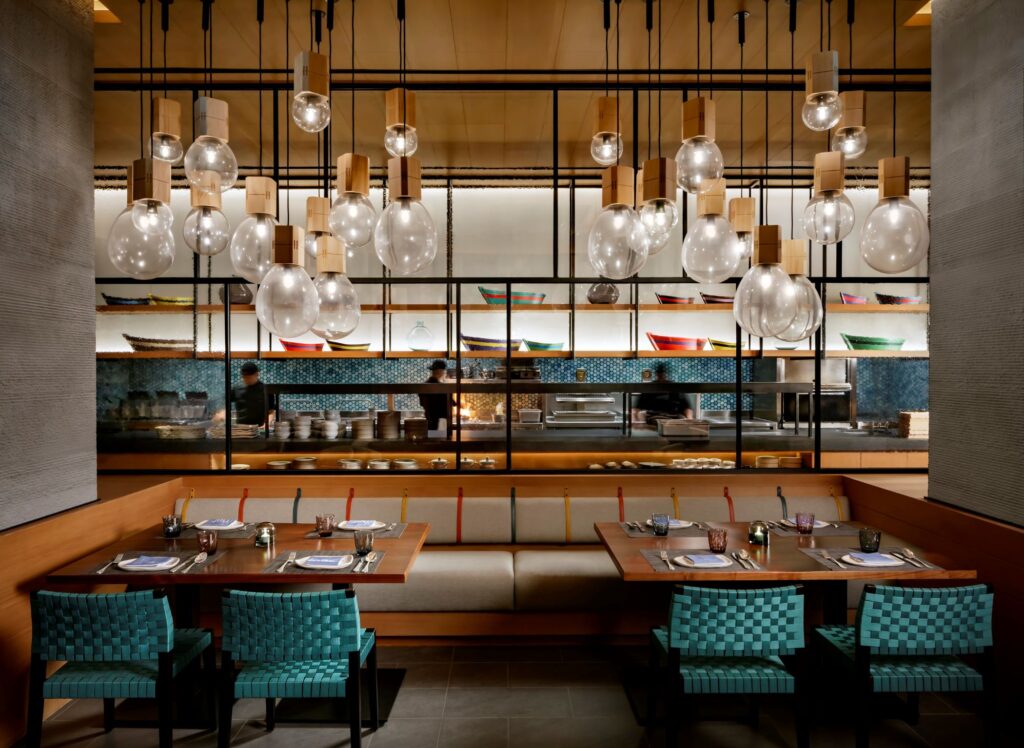Design within Atlantis
La Mar by Gastón Acurio is a new Peruvian restaurant in Dubai that offers diners the chance to explore the authentic flavours of Peruvian gastronomy.
Peruvian cuisine is most heavily influenced by the variety of ethnic backgrounds found throughout the country.
The blending of these cultures mixed with Peru’s unusually large number of climate changes, combined with its unique, indigenous agriculture, is what gives Peruvian cuisine its edge and puts it amongst some of the best cuisines around the world.
New York based Jeffrey Beers International (JBI), a full service studio that specializes in architecture, design, and planning for hotels and restaurants, were commissioned to design the interiors of La Mar by Gastón Acurio.
JBI have an international reputation for delivering projects with bespoke, custom fixtures and sensitivity to the texture and colour of materials used.
We are grateful to the Principal of JBI, Tim Rooney, for taking time to discuss the project and how the country of Peru, with its vibrant colours, has influenced his work.
GS Magazine: What was the design brief?
Tim Rooney: Chef Gaston Acurio opened the first La Mar in the Miraflores neighbourhood of Lima, Peru.
He was inspired by the casual feet-in-the-sand beachside ceviche stands he grew up with in Lima and wanted to elevate the cuisine and make the world take notice.
Chef Gaston brought that casual ‘beachside’ character into the first La Mar with rustic materials and nods to fishing culture and traditions in the decor.
Bringing the essence of the La Mar brand to Atlantis The Royal in Dubai challenged us to design an elegantly casual and energetic restaurant that would live harmoniously with the more polished aesthetics of the resort.
We wanted this restaurant to feel as comfortable and inviting to His Excellency as it would a Peruvian guest familiar with the bustling ceviche culture of Lima.

GS: In what way would you say that the design details were inspired by Peru’s coastline?
TR: The materiality, colour and vibe were all inspired by the coastline of Peru.
The various shades of blue in the accent tiles at the Ceviche Bar and Expo Kitchen along with the turquoise green of the dining chairs all represent the shades of the ocean.
The woods and stone, both as materials and textures, are all inspired by the rich history of beachside ceviche stands and rough seaside cliffs.
Most importantly, the vibe is meant to evoke the deeply rooted connection Peruvians have with the sea.
From the native American reed boats and brilliantly painted wooden fishing boats of today to the vibrant surfing culture – the vibe of La Mar is deeply influenced by the Peruvian connection between their food and culture.
GS: What do the pops of colour represent?
TR: The pops of colour represent the various shades of blues and blue greens seen in the Pacific Ocean off the coast of Peru as well as the colourful wooden fishing boats that adorn the coast.
These colours were incorporated into the decorative tiles and into the furniture with the straps of the chairs and decorative leather straps on the banquettes.

GS: Is the design similar to La Mar restaurant in Lima and, if so, in what way?
TR: There are several details in Dubai that are a nod to the original Lima restaurant.
In additional to the overall colour palette with its use of warm wood tones and grey stones, the blue strap detail in the main dining chair is a consistent design element in all La Mar restaurants.
We also incorporated the playful chalk board detail, that reminds us of the beachside ceviche stands in Lima, over the iced fish display at the Ceviche Bar.
GS: What were the dominant materials in the design and why?
TR: The materials were inspired by the original La Mar restaurant in Lima Peru and the beachside ceviche stands that inspired design.
The materials used were not as rustic as those found at those locations but the use of warm wood planks on the ceilings and walls surround the guests in warmth.
Soft grey stone on the flooring created a visual foundation for the space and recalls the flooring in Lima.
Chiselled stone on the columns and flamed finished granite at the bar recall the rustic cliffs of Peru.
Patinaed copper and bronze were used as accents and remind us of the elaborate colourful metal doors we see throughout Peru.

GS: What’s the story behind the beautiful wall screen?
TR: We wanted a strong three dimensional art moment to anchor the space next to the Ceviche Bar and provide a beautiful backdrop for the private dining table.
This art work is commissioned through the art consultant Capsule Arts from an artist named Cecilia Levy and is created from layers of pages from books, burnished and hand painted in shades of blues and greens and formed into open bowl or cup shaded pieces.
The composition of the pieces on the subtle textured plaster backdrop is an artwork in itself.

GS: Please tell us about the artwork?
TR: We worked with Capsule Arts to commission all of the artwork in the space.
The artwork was meant to showcase the artwork and crafts of Peru and speak to the crafted quality of the food.
From the handwoven colourful tapestry at the entry by Cynthia Malamud, to the hand painted textured wood panel at the bar, to the hand crafted painted paper pods at the Ceviche Bar by Cecilia Levy, the art provided a layer of colour and texture to the space.

GS: Did you employ a Lighting Consultant?
TR: Lighting was a very important element in the design of the restaurant.
We worked with Light Touch to design the lighting throughout the restaurant.
During the day, the space is filled with natural light from floor-to-ceiling wall-to-wall operable glass doors.
At night, the space transforms and lighting provides a warm soothing glow to the space.
The artwork and textured surfaces are grazed with light and each of the three activity stations (Bar, Ceviche Bar and Theatre Kitchen) glow with light to provide an active theatrical backdrop for the dining guests.

GS: How did you integrate the design of the kitchen with the restaurant interior?
TR: Celebrating Chef Gaston Acurio’s food and the theatre of creating his food was the main focus of our design.
We designed the restaurant to be surrounded by activity.
On all four sides, from the Bar, to the view of Dubai, to the Ceviche Bar, and finally the Theatre Kitchen – activity and energy surrounds the guests.
Creating layers of transparent screens between the dining room and Theatre Kitchen allowed the flow and efficiency of service to operate smoothly while maintaining the direct connection to all the action.
A peek-a-boo window at the entry provides your first view to the Theatre Kitchen then it provides a backdrop to every seat in the dining room.
GS: What aspect are you most pleased with on this project?
TR: We are thrilled with the energy and sense of whimsy this space has created.
The amazing food and atmosphere combine to provide a fun and memorable experience.
There is a sense of discovery in the restaurant with something different and unexpected to see at every turn.
GS: What makes Jeffrey Beers International unique?
TR: Our team is astute, skilful, and collaborative.
We are passionate about what we do. Our designs balance discipline with spontaneity and blend Modernism with the warmth of artisanal techniques.
This creative dialogue defines the ethos of JBI where we bring architecture and artistry together.







